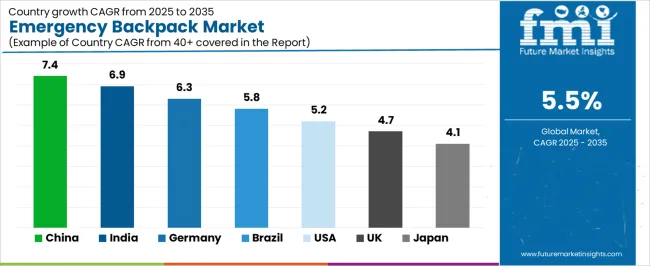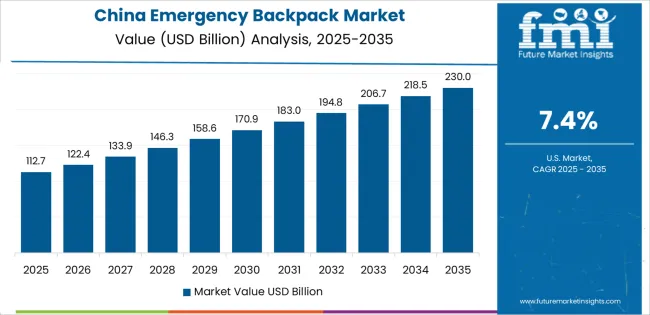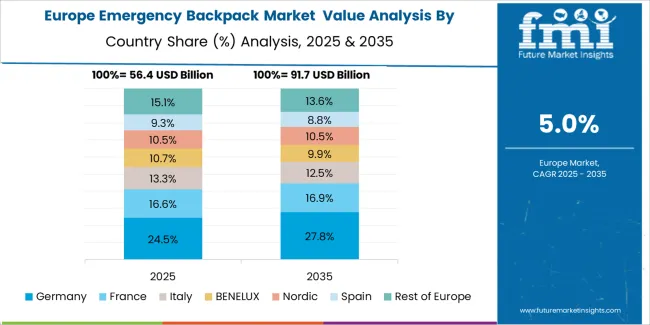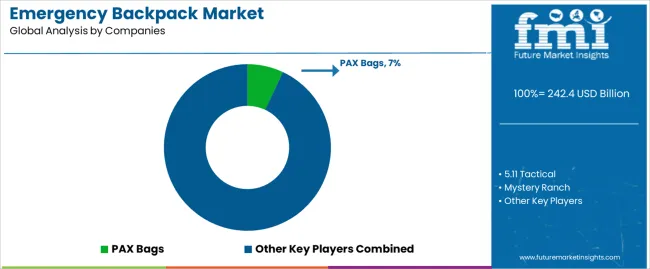The global emergency backpack market is valued at USD 242.4 million in 2025. It is slated to reach USD 414.2 million by 2035, recording an absolute increase of USD 323.5 million over the forecast period. This expansion is supported by rising institutional preparedness requirements, specialization of tactical response equipment, and broadening adoption of standardized emergency kits across healthcare, defense, industrial, and civic safety environments. From a production standpoint, the market is shaped by textile manufacturing capabilities and material-engineering advances, with suppliers increasingly relying on high-denier nylon fabrics, tear-resistant laminates, water-repellent coatings, and reinforced stitching to ensure field durability. Most large-volume production remains concentrated in East and Southeast Asia due to cost efficiencies and established technical sewing infrastructure, while North American and European manufacturers focus on specialized, compliance-certified emergency medical packs and defense-grade tactical systems.
Supply chains are evolving toward modularity, with manufacturers offering customizable interior layouts, MOLLE attachment points, and color-coded compartment systems that support rapid equipment access in high-stress environments. End-use applications differ significantly: emergency medical services and hospitals require organized trauma, airway, and medication packs; military and law enforcement users prioritize load-bearing efficiency, stealth, and integration with body armor; industrial safety teams adopt multi-hazard response backpacks for confined space rescue and chemical exposure scenarios; and public agencies and corporate workplaces increasingly procure disaster-readiness kits for evacuation, first-response continuity, and incident stabilization.

From 2030 to 2035, the market is forecast to grow from USD 185.5 million to USD 414.2 million, adding another USD 228.7 million, which constitutes 70.7% of the overall ten-year expansion. This period is expected to be characterized by the expansion of industrial safety programs and workplace emergency protocols, the development of advanced materials and ergonomic designs for extended field operations, and the growth of specialized applications for fire rescue operations and disaster response teams. The growing adoption of comprehensive safety standards and emergency response protocols will drive demand for emergency backpacks with enhanced functionality and durability features.
Between 2020 and 2025, the emergency backpack market experienced steady growth, driven by increasing awareness of emergency preparedness standards and growing recognition of emergency backpacks as essential equipment for enhancing response capabilities across law enforcement, healthcare, and industrial safety applications. The market developed as safety professionals and emergency responders recognized the potential for specialized backpack systems to improve equipment organization, enhance operational mobility, and support rapid response objectives while meeting stringent durability requirements. Technological advancement in materials and design began emphasizing the importance of maintaining load distribution and accessibility in challenging operational environments.
| Metric | Value |
|---|---|
| Estimated Value in (2025E) | USD 242.4 million |
| Forecast Value in (2035F) | USD 414.2 million |
| Forecast CAGR (2025 to 2035) | 5.5% |
Market expansion is being supported by the increasing global demand for emergency preparedness solutions driven by natural disaster frequency and growing public safety awareness, alongside the corresponding need for specialized tactical equipment that can enhance operational effectiveness, enable organized medical response, and maintain equipment readiness across law enforcement, healthcare, fire rescue, and industrial safety applications. Emergency responders and safety professionals are increasingly focused on implementing emergency backpack solutions that can improve equipment accessibility, enhance mobility in challenging environments, and provide reliable performance in demanding operational conditions.
The growing emphasis on workplace safety and comprehensive emergency protocols is driving demand for emergency backpacks that can support industrial safety programs, enable rapid medical response, and ensure organized equipment deployment. Safety professionals' preference for tactical equipment that combines durability with organizational efficiency and ergonomic design is creating opportunities for innovative emergency backpack implementations. The rising influence of military-grade standards and advanced materials technology is also contributing to increased adoption of emergency backpacks that can provide superior load-bearing capabilities without compromising mobility or operational functionality.
The market is segmented by capacity type, application, and region. By capacity type, the market is divided into large capacity and small and medium capacity. Based on application, the market is categorized into hospital & clinic, fire rescue, industrial safety, police & military, and others. Regionally, the market is divided into East Asia, Europe, North America, South Asia, Latin America, Middle East & Africa, and Eastern Europe.

The large capacity segment is projected to maintain its leading position with 45% market share in the emergency backpack market in 2025, reaffirming its role as the preferred capacity category for comprehensive emergency response and extended field operations. Emergency responders and tactical personnel increasingly utilize large capacity backpacks for their superior equipment storage capabilities, excellent organizational features, and proven effectiveness in supporting multi-day operations while maintaining accessibility to critical supplies. Large capacity backpack technology's proven effectiveness and application versatility directly address the industry requirements for comprehensive emergency preparedness and sustained operational deployment across diverse emergency response scenarios and professional applications.
This capacity segment forms the foundation of modern emergency response operations, as it represents the equipment configuration with the greatest contribution to operational readiness and established performance record across multiple emergency applications and professional sectors. Emergency services investments in comprehensive equipment systems continue to strengthen adoption among responders and safety professionals. With operational requirements demanding extensive medical supplies and specialized equipment, large capacity backpacks align with both functionality objectives and operational demands, making them the central component of comprehensive emergency response strategies.

The hospital & clinic application segment is projected to represent 60% share of emergency backpack demand in 2025, underscoring its role as a primary driver for emergency backpack adoption across emergency departments, ambulance services, and mobile medical response units. Healthcare facilities prefer emergency backpacks for medical response due to their exceptional organizational capabilities, equipment protection features, and ability to maintain sterile supply separation while supporting rapid deployment and regulatory compliance. Positioned as essential equipment for modern emergency medical services, emergency backpacks offer both operational advantages and patient care benefits.
The segment is supported by continuous innovation in medical response protocols and the growing availability of specialized backpack configurations that enable superior medical supply organization with enhanced accessibility and reduced response time. Healthcare providers are investing in comprehensive emergency backpack programs to support increasingly stringent medical response standards and patient safety requirements. As emergency medical services expand and healthcare protocols advance, the hospital & clinic application will continue to represent significant market demand while supporting advanced equipment utilization and medical response optimization strategies.
The emergency backpack market is advancing steadily due to increasing demand for emergency preparedness solutions driven by disaster management requirements and growing adoption of tactical equipment standards that require specialized gear providing enhanced durability characteristics and organizational benefits across healthcare, law enforcement, fire rescue, and industrial safety applications. However, the market faces challenges, including high costs for premium tactical-grade equipment, competition from alternative carry systems and equipment configurations, and budget constraints in public sector procurement. Innovation in advanced materials technology and ergonomic design continues to influence product development and market expansion patterns.
The growing focus on disaster preparedness is driving demand for specialized emergency equipment that addresses response requirements including rapid deployment capabilities, comprehensive medical supply organization, and durable construction for harsh environmental conditions. Emergency response operations require advanced emergency backpack configurations that deliver superior performance across multiple parameters while maintaining accessibility and cost-effectiveness. Safety agencies are increasingly recognizing the competitive advantages of emergency backpack integration for disaster response development and operational capability, creating opportunities for innovative designs specifically engineered for comprehensive emergency management applications.
Modern emergency backpack manufacturers are incorporating advanced materials and ergonomic design principles to enhance operational performance, reduce user fatigue, and support comprehensive mobility objectives through optimized load distribution systems and lightweight construction. Leading companies are developing backpacks with reinforced ballistic materials, implementing modular attachment systems, and advancing design technologies that minimize physical strain and maximize operational efficiency. These technologies improve field capabilities while enabling new market opportunities, including extended duration operations, specialized tactical applications, and ergonomically optimized equipment systems. Advanced design integration also allows manufacturers to support comprehensive operational effectiveness objectives and market differentiation beyond traditional equipment attributes.
The expansion of specialized professional applications across law enforcement, military operations, and industrial safety is driving demand for customized emergency backpack configurations with precisely organized compartment systems and application-specific features. These professional applications require specialized designs with stringent durability specifications that exceed consumer-grade requirements, creating premium market segments with differentiated value propositions. Manufacturers are investing in specialized design capabilities and field testing programs to serve emerging professional applications while supporting innovation in tactical operations, emergency response, and safety management sectors.

| Country | CAGR (2025-2035) |
|---|---|
| India | 6.9% |
| China | 7.4% |
| Germany | 6.3% |
| Brazil | 5.8% |
| USA | 5.2% |
| UK | 4.7% |
| Japan | 4.1% |
The emergency backpack market is experiencing solid growth globally, with China leading at a 7.4% CAGR through 2035, driven by expanding law enforcement equipment modernization, growing industrial safety regulations, and increasing adoption of professional tactical gear across security services. India follows at 6.9%, supported by growing disaster management programs, expanding healthcare infrastructure, and rising awareness of emergency preparedness. Germany shows growth at 6.3%, emphasizing premium tactical equipment standards, professional rescue service requirements, and advanced materials engineering.
Brazil demonstrates 5.8% growth, supported by expanding public safety programs, growing industrial safety emphasis, and increasing emergency response infrastructure. The United States records 5.2%, focusing on military-grade tactical equipment, law enforcement modernization, and emergency medical services enhancement. The United Kingdom exhibits 4.7% growth, emphasizing professional emergency services equipment and workplace safety compliance. Japan shows 4.1% growth, supported by disaster preparedness culture and precision equipment manufacturing.
The report covers an in-depth analysis of 40+ countries top-performing countries are highlighted below.

Revenue from emergency backpacks in China is projected to exhibit exceptional growth with a CAGR of 7.4% through 2035, driven by expanding law enforcement equipment modernization programs and rapidly growing industrial safety and emergency response sectors supported by government safety initiatives and professional standards development. The country's massive security services expansion and increasing investment in emergency preparedness technologies are creating substantial demand for emergency backpack solutions. Major tactical equipment manufacturers and safety equipment companies are establishing comprehensive production capabilities to serve both domestic markets and export opportunities.
Revenue from emergency backpacks in India is expanding at a CAGR of 6.9%, supported by growing disaster management programs, expanding healthcare infrastructure, and increasing awareness of emergency preparedness across government and private sector organizations. The country's comprehensive safety infrastructure development and regulatory advancement are driving adoption of professional emergency equipment throughout diverse sectors. Leading safety equipment suppliers and international manufacturers are establishing production and distribution facilities to address growing domestic demand.
Revenue from emergency backpacks in Germany is expanding at a CAGR of 6.3%, supported by the country's emphasis on premium tactical equipment standards, professional rescue service requirements, and advanced materials engineering capabilities. The nation's professional emergency services excellence and precision manufacturing are driving demand for high-specification emergency backpacks. Leading tactical equipment manufacturers and emergency services suppliers are investing extensively in advanced design technologies and specialized applications.
Revenue from emergency backpacks in Brazil is expanding at a CAGR of 5.8%, supported by expanding public safety programs, growing industrial safety emphasis, and increasing emergency response infrastructure development. The nation's developing safety infrastructure and operational capability enhancement are driving demand for professional emergency equipment solutions. Safety equipment distributors and tactical gear suppliers are investing in market development and product availability to serve growing demand.
Revenue from emergency backpacks in the United States is expanding at a CAGR of 5.2%, supported by the country's focus on military-grade tactical equipment, law enforcement modernization programs, and emergency medical services enhancement. The nation's comprehensive professional emergency services and tactical equipment industry are driving demand for high-performance emergency backpack solutions. Tactical gear manufacturers and emergency equipment companies are investing in design innovation and production capabilities to serve both government and commercial markets.
Revenue from emergency backpacks in the United Kingdom is expanding at a CAGR of 4.7%, driven by the country's professional emergency services equipment standards, workplace safety compliance requirements, and operational effectiveness emphasis. UK's emergency services professionalism and safety culture are driving demand for quality emergency backpack solutions. Emergency equipment suppliers and tactical gear distributors are establishing comprehensive programs for professional equipment provision.
Revenue from emergency backpacks in Japan is expanding at a CAGR of 4.1%, supported by the country's disaster preparedness culture, precision equipment manufacturing, and strong emphasis on quality and reliability in emergency equipment. Japan's preparedness consciousness and manufacturing excellence are driving demand for high-quality emergency backpack products. Emergency equipment manufacturers and safety product companies are investing in specialized capabilities for domestic market requirements.

The emergency backpack market in Europe is projected to grow from USD 18.5 million in 2025 to USD 85.3 million by 2035, registering a CAGR of 5.5% over the forecast period. Germany is expected to maintain leadership with a 24.5% market share in 2025, moderating to 23.8% by 2035, supported by professional rescue services, tactical equipment standards, and strong manufacturing expertise.
The United Kingdom follows with 18.2% in 2025, projected at 17.6% by 2035, driven by emergency services modernization, workplace safety regulations, and professional equipment procurement. France holds 15.8% in 2025, reaching 16.1% by 2035 on the back of fire brigade equipment programs and public safety initiatives. Italy commands 12.3% in 2025, rising slightly to 12.5% by 2035, while Spain accounts for 9.4% in 2025, reaching 9.7% by 2035 aided by emergency response development and industrial safety growth.
The Netherlands maintains 6.1% in 2025, up to 6.3% by 2035 due to professional emergency services and safety compliance. The Rest of Europe region, including Nordics, Central & Eastern Europe, and other markets, is anticipated to hold 13.7% in 2025 and 14.0% by 2035, reflecting steady advancement in emergency preparedness programs and professional equipment adoption.

The emergency backpack market is characterized by competition among specialized tactical equipment manufacturers, emergency equipment suppliers, and professional gear producers. Companies are investing in advanced materials development, ergonomic design innovation, product configuration expansion, and application-specific feature development to deliver high-performance, durable, and user-friendly emergency backpack solutions. Innovation in modular attachment systems, lightweight composite materials, and specialized compartment configurations is central to strengthening market position and competitive advantage.
PAX Bags maintains strong market presence, offering comprehensive emergency backpack solutions with focus on medical response applications, professional design standards, and specialized configurations across healthcare and emergency services sectors. 5.11 Tactical provides innovative tactical gear with emphasis on law enforcement and professional applications, featuring durable construction and modular systems. Mystery Ranch delivers high-performance backpacks with focus on load-bearing excellence and ergonomic design for extended operations. Blackhawk offers tactical equipment solutions with emphasis on military and law enforcement applications. Vanquest provides specialized tactical gear focusing on organizational systems and durability. Direct Action emphasizes military-grade equipment and professional tactical applications. First Tactical offers law enforcement and emergency services equipment. Condor Outdoor provides tactical gear solutions for diverse professional applications.
Additional manufacturers including Savotta, Eberlestock, Helikon-Tex, Maxpedition, Tasmanian Tiger, Recon Essentials, and London Bridge Trading contribute to market diversity with specialized product offerings serving specific operational requirements and regional markets.
Emergency backpacks represent a specialized tactical equipment segment within professional and safety applications, projected to grow from USD 242.4 million in 2025 to USD 414.2 million by 2035 at a 5.5% CAGR. These specialized equipment systems—primarily large and medium capacity configurations for professional applications—serve as essential tools in emergency medical response, law enforcement operations, fire rescue services, and industrial safety programs where enhanced durability, organizational efficiency, and operational mobility are essential. Market expansion is driven by increasing disaster preparedness awareness, growing professional tactical equipment standards, expanding emergency medical services infrastructure, and rising demand for workplace safety solutions across government, healthcare, and industrial sectors.
How Safety Regulators Could Strengthen Equipment Standards and Operational Effectiveness?
How Industry Associations Could Advance Equipment Standards and Professional Development?
How Emergency Backpack Manufacturers Could Drive Innovation and Market Leadership?
How End-User Organizations Could Optimize Equipment Performance and Operational Effectiveness?
How Research Institutions Could Enable Technology Advancement?
How Procurement Agencies and Budget Authorities Could Support Market Growth and Capability Enhancement?
| Items | Values |
|---|---|
| Quantitative Units (2025) | USD 242.4 million |
| Capacity Type | Large Capacity, Small and Medium Capacity |
| Application | Hospital & Clinic, Fire Rescue, Industrial Safety, Police & Military, Others |
| Regions Covered | East Asia, Europe, North America, South Asia, Latin America, Middle East & Africa, Eastern Europe |
| Countries Covered | China, India, Germany, Brazil, United States, United Kingdom, Japan, and 40+ countries |
| Key Companies Profiled | PAX Bags, 5.11 Tactical, Mystery Ranch, Blackhawk, Vanquest, Direct Action, First Tactical, Condor Outdoor |
| Additional Attributes | Dollar sales by capacity type and application category, regional demand trends, competitive landscape, technological advancements in materials and design, professional equipment standards, ergonomic innovation, and operational performance optimization |
The global emergency backpack market is estimated to be valued at USD 242.4 billion in 2025.
The market size for the emergency backpack market is projected to reach USD 414.1 billion by 2035.
The emergency backpack market is expected to grow at a 5.5% CAGR between 2025 and 2035.
The key product types in emergency backpack market are large capacity and small and medium capacity.
In terms of application, hospital & clinic segment to command 60.0% share in the emergency backpack market in 2025.






Full Research Suite comprises of:
Market outlook & trends analysis
Interviews & case studies
Strategic recommendations
Vendor profiles & capabilities analysis
5-year forecasts
8 regions and 60+ country-level data splits
Market segment data splits
12 months of continuous data updates
DELIVERED AS:
PDF EXCEL ONLINE
Emergency Transfer Vacuum Mattress Market Size and Share Forecast Outlook 2025 to 2035
Emergency Communication Vehicle Market Size and Share Forecast Outlook 2025 to 2035
Emergency Lighting Market Growth - Trends & Forecast 2025 to 2035
Emergency Light Sticks Market Analysis and Forecast by Type, Distribution Channel, End Use, and Region through 2035
Emergency Spill Response Market Growth - Size, Trends & Forecast 2025 to 2035
Emergency Shutdown System Market Trends - Growth & Forecast 2025 to 2035
Emergency Medical Services Market Overview – Trends & Industry Outlook 2024-2034
Emergency Vent Cover Market Growth – Trends & Forecast 2024-2034
Emergency Venting System Market Growth – Trends & Forecast 2024-2034
Emergency Response and Rescue Vessels Market
Emergency Beacon Transmitter Market
EMEA Emergency Medical Service Market Analysis by Services, Provider, Fleet, and Region Forecast Through 2035
Railway Emergency Valves Market Trends and Forecast 2025 to 2035
Personal Emergency Response System (PERS) Market Size and Share Forecast Outlook 2025 to 2035
Automatic Emergency Braking System Market Size and Share Forecast Outlook 2025 to 2035
Automatic Emergency Braking (AEB) Market Size and Share Forecast Outlook 2025 to 2035
Drones For Emergency Responders Market Size and Share Forecast Outlook 2025 to 2035
Automotive Emergency Braking System Market - Size, Share, and Forecast 2025 to 2035
Backpack Systems Market Size and Share Forecast Outlook 2025 to 2035
Backpacker Gears Market Analysis - Size and Share Forecast Outlook 2025 to 2035

Thank you!
You will receive an email from our Business Development Manager. Please be sure to check your SPAM/JUNK folder too.
Chat With
MaRIA